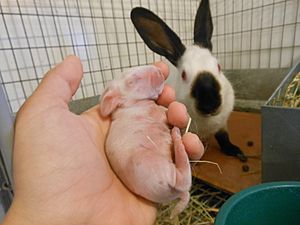Laurices facts for kids
Laurices is a historical term for very young rabbits that were prepared and eaten as a special food. The word comes from the Latin word laurex. Because they were small, people usually served more than one at a time. The ancient Romans learned about rabbits from Spain, and the custom of eating laurices spread across western Europe.
As people started raising rabbits on farms, they could get laurices from newborn rabbits. This meant they didn't have to sacrifice the mother rabbit, as they could watch for the birth.
Contents
History of Laurices
Earliest Mentions
The first known mention of laurices as a food comes from Pliny the Elder (23–79 AD). He wrote about them in his book Naturalis Historia.
Pliny described how rabbits were very common in Spain. He said they caused hunger in the Balearic Islands by eating crops. He also wrote that very young rabbits, taken from the mother or from her milk, were considered a delicious food. These were called laurices.
Gregory of Tours and Lent
The consumption of laurices was also mentioned by Gregory of Tours (around 538–594 AD). In his book Historia Francorum ("History of the Franks"), he wrote about people eating "baby rabbits" during the Christian fasting period of Lent.
In one part, Gregory describes a man named Roccolen who was sick. Roccolen "kept on eating baby rabbits" during Lent. Gregory of Tours did not like Roccolen, so this mention might have been a way to show Roccolen was not following religious rules.
Clearing Up a Myth
There's a common story that Pope Gregory I (540–604 AD) said it was okay to eat laurices during Lent. The story says he declared them to be like fish or shellfish, which were allowed during fasts.
However, this story is not true. The myth comes from people confusing Gregory of Tours with Pope Gregory I. They were two different people living at the same time. This myth also led to the false idea that rabbits were first raised by humans around 600 AD.
See also
 In Spanish: Laurices para niños
In Spanish: Laurices para niños


